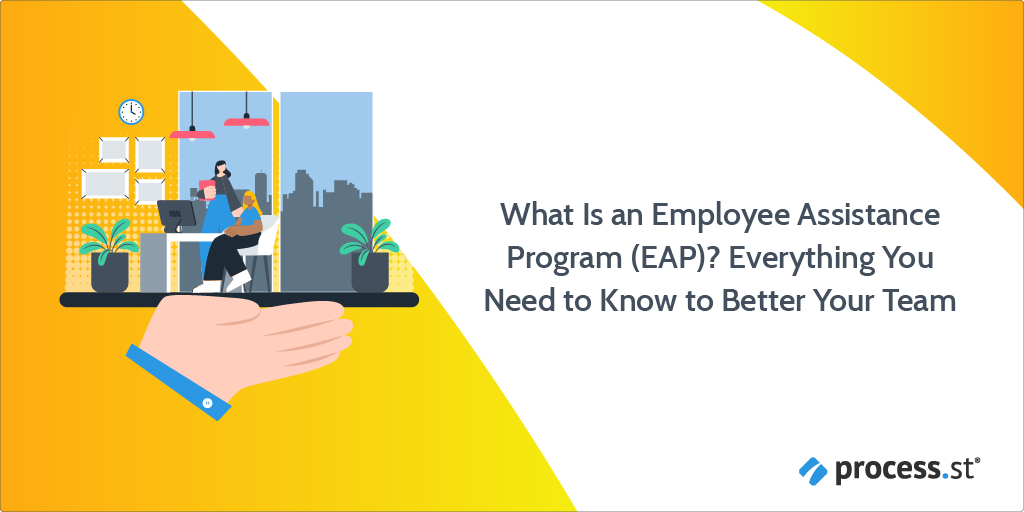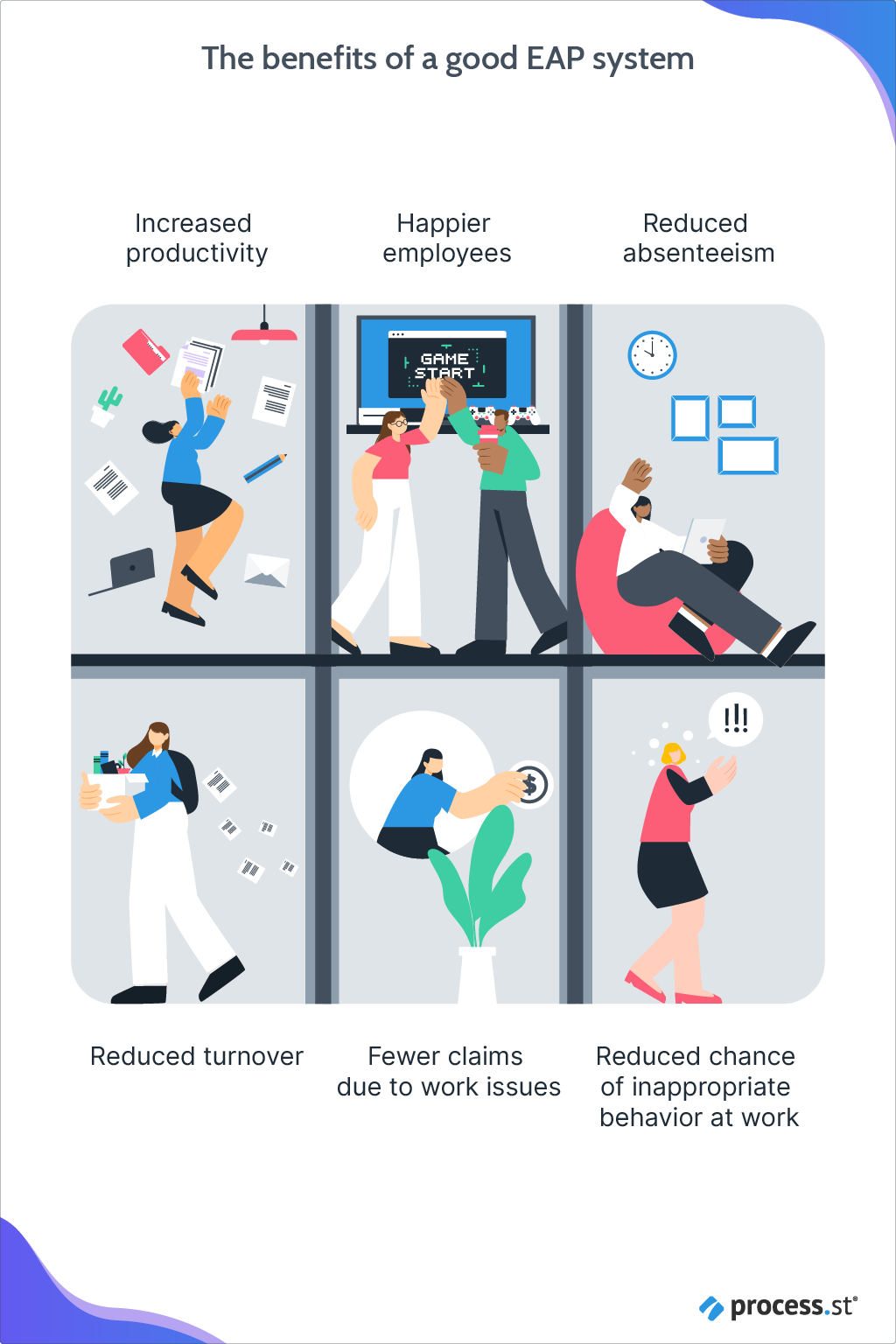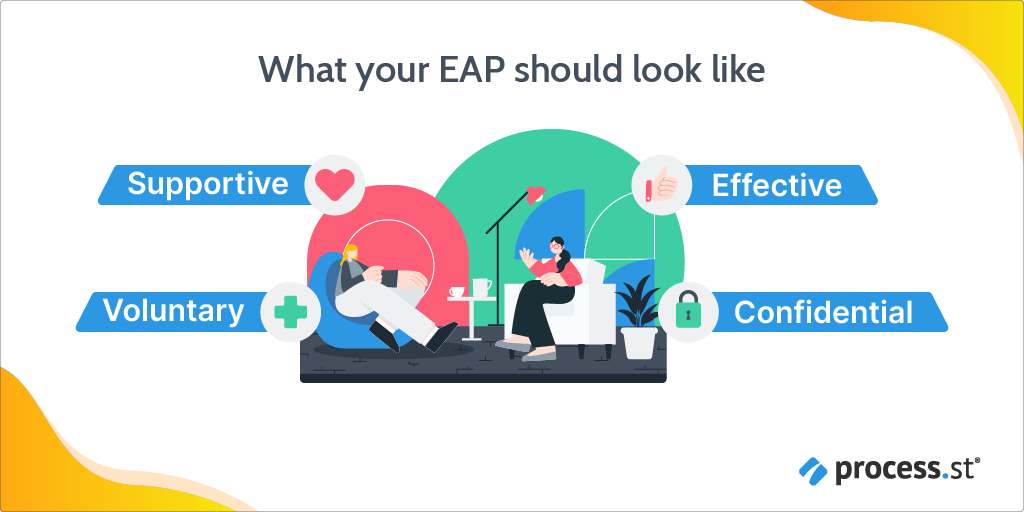
I felt numb.
My relationship of the last 2 years had just collapsed, which was the straw that broke… well, my head. I spiraled into a mental breakdown.
I was living in Italy without knowing anyone but my (now ex) girlfriend, living in the same apartment as her, not being able to speak the language, and around $4,000 down in my bank account from when we’d moved there two months prior.
And yet, thanks to our employee assistance program here at Process Street, I was able to get back to England safe and sound. And without worries about getting fired adding fuel to my problems.
“US businesses lose up to $300 billion dollars due to work-related stress. While the root-cause is a grueling work-culture that has gone unchecked for decades, an EAP can help to a great extent.”
– HR University, 7 Best Employee Assistance Programs in 2022
No matter how focused and productive an employee is, there will be times when they encounter personal problems that affect their work. That’s where employee assistance programs (EAPs) come in.
EAPs exist to listen to your team’s problems and help them through whatever they’re experiencing. In other words, every team should have access to some kind of EAP.
That’s why this post will take you through:
- What is an employee assistance program (EAP)?
- Employee assistance program benefits
- How to set up an EAP
- Process Street helps you perfect the employee assistance program
Let’s dive right in.
What is an employee assistance program (EAP)?
An employee assistance program (EAP) is a service that an employer or union provides to help employees deal with personal problems. While the problems can be caused by anything, the focus is on things that affect work performance – this can even extend to the employee’s family too.
Think of it as a broader idea of what a typical HR team does. The program helps employees with their problems, but has a wider focus to include personal problems and provides an actionable way to tackle difficult issues.
These issues can include (but aren’t limited to):
- Stress
- Burnout
- Work conflicts
- Depression
- Substance abuse
- Addiction
- Bereavement
- Marital and relationship issues
- Financial worries
The services the employee assistance program provides largely depend on the issue they’re tackling with an employee. It can be anything from assessments and short-term counseling to referral to more dedicated services.
It’s not a service that pretends to know everything.
If issues can be resolved (or, at least, mitigated and helped) then that’s fantastic. However, for more serious issues such as substance abuse, marital issues, severe depression and so on, the team must know who is best to refer the employee to.
Employee assistance programs also come in many shapes and sizes. Some are managed in-house, others are partially or entirely outsourced. Some focus on a single organization, others can be employed by a group of small businesses or a union on behalf of many different teams.
Employee assistance program benefits
Let’s start strong with a list of the benefits of an EAP before we dive into the details:
- Increased productivity
- Happier employees
- Reduced absenteeism
- Reduced employee turnover
- Fewer claims due to work issues
- Reduced chance of inappropriate behavior at work

The first question with any employee benefits scheme tends to be the cost. Thankfully, this is one area in which employee assistance programs excel.
Since the issues that are targeted can often cause low productivity, absenteeism, extended time off, or even complete employee turnover, the cost of these services is offset by the savings provided by a more productive, dedicated, happy workforce.
This might sound like corporate-speak with no teeth, but I can tell you from personal experience how reassuring it is when your work helps to support you through your troubles.
My experience with mental health and EAPs
“In the United States, almost half of adults (46.4 percent) will experience a mental illness during their lifetime. 5 percent of adults (18 or older) experience a mental illness in any one year, equivalent to 43.8 million people.”
– Mental Health First Aid, 5 Surprising Mental Health Statistics
I won’t pretend to be qualified to talk about issues such as domestic abuse, toxic work colleagues, or any number of issues that EAPs have to deal with daily.
I do, however, have a bit of experience with mental health issues.
While medication has made things more consistent, my mental health fluctuates due to depression and anxiety and has done for around 14 years now. This sometimes results in me needing to take a day off due to panic attacks, fatigue, and other issues.
I constantly suffer from impostor syndrome. My sleep schedule is a permanent battle.
Plus, whenever I’m unable to pull a solid day of work, my mind begins to spiral into (unfounded) thoughts of how I’ll be fired, which leads to financial worries and… Well, you get the picture. My brain has a wonderful talent for spiraling.
If my manager didn’t encourage me to talk about it to him and keep the team posted then I would probably sit in silence, missing the odd day until I was eventually fired for perceived laziness.
However, the truth is that we’re only human, and everyone has problems. Heck, the National Science Foundation has found that 80% of our daily thoughts are negative.
My team knows that I can get my work done. They’ve seen me knock it out of the park time and again even when my mental health is taking a dive, and are understanding of the times that I can’t perform at my best (if at all).
Every two weeks, we have a dedicated meeting to catch up and check on everyone’s status. If things get bad in the meantime, I know that I can message our team lead or any number of my teammates for support.
After all, the ultimate goal of an employee assistance program isn’t to treat everyone the same and try to find a quick-fix for every solution. It’s to recognize the problems that your employees face and help them to deal with them in a reasonable manner that benefits both parties.
The more people that have the support they need to deal with their issues, the more talented employees your team will have.
How to set up an EAP
“When setting up the EAP system, HR Managers need to understand why they are setting up this system in the first place. What’s the problem that they are trying to solve? Then, they must ensure they are able to provide adequate funding to support the EAP system so that it can be successful.”
– Jeff Harry, Founder of Rediscover Your Play
As Jeff states, the starting point for every EAP is to look at why you’re setting up this program in the first place. Once you know these reasons, you can take a further look into what problems you want to solve and how much funding will be needed to ensure you’re successful in solving them.
Unfortunately, setting up an EAP isn’t as simple as “come to us with your problems and we’ll try to help”. Your employee assistance program needs to meet a minimum set of criteria to cover your organization in the event of a problem.
Not to mention that it can be dangerous to offer these kinds of services if you’re not trained to deal with the issues that arise.
The good news is that there are plenty of options for outsourcing your program if you’re not able to put the resources into setting up your own.
So, let’s cover what you need to know to set up your employee assistance program and what those outsourcing options are.

Crucial employee assistance program elements
At the very core of any decent EAP is confidentiality.
The problems that your team is dealing with are personal and need to be kept confidential. They’re approaching you in confidence with some potentially sensitive topics – the worst thing that you could do is break that trust and leak the information, intentionally or otherwise.
To go into a more exhaustive list, an EAP must:
- Ensure confidentiality via written policies;
- Have trained staff and processes to monitor and follow up with clients;
- Contain professionals qualified to deal with potential issues who maintain and improve their abilities according to new discoveries;
- Produce a policy detailing the scope and limitations of the EAP;
- Implement an advisory process involving figures from across your entire organization;
- Have flexibility to add services if required to suit employee needs;
- Supply a crisis intervention service that is available 24/7;
- Have a set method for determining whether to supply a short-term solution itself or to refer the client to other services (e.g. professional counseling);
- Provide training for leaders in the organization to help them identify issues early and refer employees to the EAP;
- Ensure that services are sensitive to language, culture, customs and beliefs held;
- Prioritize access and quality over the cost of services – the goal is to help employees.
To learn more about the requirements of setting up your EAP, I’d highly recommend checking out the Employee Assistance Program Association’s (EAPA) work on the subject:
- EAP Resources
- EAPA Standards Framework
- Designing and testing a Return on Investment tool for EAPs
- Counselor’s guide to working with EAPs
- UK EAPA factsheet – Mental health in the workplace (2017)
However, to summarize, the majority of requirements in setting up an EAP is to document everything thoroughly, supply the appropriate level of trained support for your team, and to make sure that their confidentiality is respected.
Outsourcing options for EAP
If your team doesn’t have the resources or know-how to set up an effective employee assistance program, there’s always the option to outsource it.
When looking for a vendor, it’s important to consider:
- How many years they’ve been in business;
- What their current clients say;
- What credentials and training they have;
- The EAP’s location;
- Whether they will be able to provide services to your team regardless of location;
- The EAP’s uptime (can night shift employees still access the service?);
- The scope of the EAP (eg, do they offer counseling for financial issues, but not sample wellness programs to try?);
- Whether the EAP would be willing (and able) to refer employees to other services if necessary;
- How the EAP tracks employee progress and follows up if necessary.
Remember that the goal here isn’t to find the cheapest service to cover the basics. Yes, you’re partially looking at the RoI the EAP will have, but the primary goal of this service is to help your employees work through their issues.
Process Street helps you perfect the employee assistance program
Whether you’re creating an employee assistance program from scratch or outsourcing the effort to a dedicated firm, you need to have documented processes. By recording the methods that have to be followed when interacting with your employees you can ensure that all of the vital aspects of an EAP are being followed.
The best way to document, track, and audit your processes is with a workflow management tool, like Process Street.
Process Street lets you record your SOPs as powerful workflow templates. These templates are made up of a list of tasks that you can populate with rich text, images, videos, links, sample emails and files, and much, much more.
This allows you to provide direct instructions on how each task should be completed. In turn, this means that everyone carrying out, say, an employee assessment, a referral to outside services, and so on, has all the tasks they need to complete right in front of them.
Not only can you document these processes, but you can also use Pages to detail how these processes should be run. Your process documentation then lives alongside your workflows in Pages, offering a centralized knowledge base for a more consistent employee assistance program.
Say goodbye to human error.
Don’t have time to document your processes from scratch? We’ve got you covered with our huge library of premade templates. These are fully built (and free to use) workflow templates that are ready-to-use as they are but can be freely edited to your needs once in your account!
Here are a few general premade templates to get you started:
- Monthly Sales Report
- Sales Forecasting Checklist
- Employee Onboarding
- Performance Review Template
- Helpdesk Management
Your workflow templates can then be run as single-instance workflows which record your progress as they’re worked through.
Custom form fields can allow the person using the checklist to record information as they go, conditional logic can create branching checklists which adapt to the situation, and approvals prevent things from moving forward without the appropriate permission.
Worried about confidentiality? No need to panic!
Process Street lets you control the permission levels of everyone in your team. This means that you have direct (and separate) control over:
- Which templates and checklists someone can see;
- Which templates someone can edit;
- Whether someone can run their own checklists or merely access an existing one they’re assigned to.
Nobody can access or even see items that you don’t want them to, meaning that employee confidentiality in your processes is assured. We’re also proud to announce Process Street’s SOC 2 Compliance and our continued commitment to protecting your data.
How do you help your employees work through their problems? We’d love to hear from you in the comments below!







 Workflows
Workflows Projects
Projects Data Sets
Data Sets Forms
Forms Pages
Pages Automations
Automations Analytics
Analytics Apps
Apps Integrations
Integrations
 Property management
Property management
 Human resources
Human resources
 Customer management
Customer management
 Information technology
Information technology



Ben Mulholland
Ben Mulholland is an Editor at Process Street, and winds down with a casual article or two on Mulholland Writing. Find him on Twitter here.